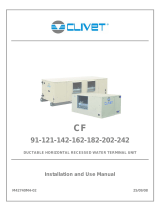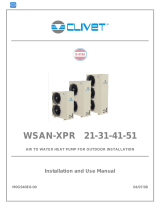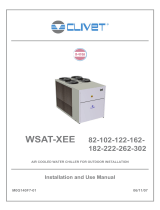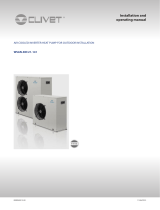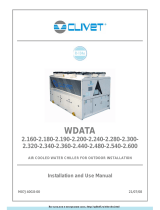Page is loading ...

M04J40H14-00 06/08/2014
SCREWLine³
Installation and
operating manual
Water chiller with remote condenser
MDE-SL3 120.1-290.1

Dear Customer,
We congratulate you on choosing this product
For many years Clivet has been oering systems that provide maximum comfort, together with high
reliability, eciency, quality and safety.
The aim of the company is to oer advanced systems, that assure the best comfort, reduce energy
consumption and the installation and maintenance cost for the life cycle of the system.
The purpose of this manual is to provide you with information that is useful from reception of
the equipment, through installation, operational usage and nally disposal so that this advanced
system oers the beat solution.
Yours faithfully.
CLIVET Spa
The data contained in this manual is not binding and may be changed by the manufacturer without
prior notice.
Reproduction, even is part, is FORBIDDEN © Copyright - CLIVET S.p.A. - Feltre (BL) - Italia

M04J40H14-00 MDE-SL3 120.1-290.1 3
Index of contents
1 General description 4
2 Reception 6
3 Positioning 8
4 Refrigeranting connections 9
5 Water connections 12
6 Electrical connections 15
7 Start-up 19
8 Control 24
9 Maintenance 28
10 Alarms - Status 31
11 Accessories 38
12 Decommissioning 48
13 Residual risks 49
14 Technical information 50
15 Dimensional drawings 53

4 MDE-SL3 120.1-290.1 M04J40H14-00
1 General description
1.1 Manual
The manual provides correct unit installation, use and maintenance.
Pay particular attention to:
Warning, identies particularly important operations or information.
Prohibited operations that must not be carried out, that compromise the operating of the unit or may cause damage to persons or things.
• It is advisable to read it carefully so you will save time during operations.
• Follow the written indications so you will not cause damages to things and injuries people.
1.2 Preliminaries
Only qualied personnel can operate on the unit, as required by the regulation in force.
1.3 Risk situations
The unit has been designed and created to prevent injures to people.
During designing it is not possible to plane and operate on all risk situation.
Read carefully “Residual risk” section where all situation which may cause damages to things and injuries to people are reported.
Installation, starting, maintenance and repair required specic knowledge; if they are carried out by inexperienced personnel, they may cause
damages to things and injuries people.
1.4 Intended use
Use the unit only:
• cooling water or a water and glycol mix for air-conditioning
• keep to the limits foreseen in the technical schedule and in this manual
The manufacturer accepts no responsibility if the equipment is used for any purpose other than the intended use.
1.5 Installation
The positioning, hydraulic system, refrigerating, electrics and the ducting of the air must be determined by the system designer in accordance
with local regulations in force.
Follow local safety regulations.
Verify that the electrical line characteristics are in compliance with data quotes on the unit serial number label.
1.6 Maintenance
Plan periodic inspection and maintenance in order to avoid or reduce repairing costs.
Turn the unit o before any operation.
1.7 Modication
All unit modications will end the warranty coverage and the manufacturer responsibility.
1.8 Breakdown/Malfuction
Disable the unit immediately in case of breakdown or malfunction.
Contact a certied service agent.
Use original spares parts only.
Using the unit in case of breakdown or malfunction:
• voids the warranty
• it may compromise the safety of the unit
• may increase time and repair costs

M04J40H14-00 MDE-SL3 120.1-290.1 5
1.9 User training
The installer has to train the user on:
• Start-up/shutdown
• Set points change
• Standby mode
• Maintenance
• What to do / what not to do in case of breakdown
1.10 Data update
Continual product improvements may imply manual data changes.
Visit manufacturer web site for updated data.
1.11 Indications for the User
Keep this manual with the wiring diagram in an accessible place for the operator.
Note the unit data label so you can provide them to the assistance centre in case of intervention (see “Unit identication” section).
Provide a unit notebook that allows any interventions carried out on the unit to be noted and tracked making it easier to suitably note the
various interventions and aids the search for any breakdowns.
In case of breakdown or malfunction:
• Immediately deactivate the unit
• Contact a service centre authorized by the manufacturer
The installer must train the user, particularly on:
• Start-up/shutdown
• Set points change
• Standby mode
• Maintenance
• What to do / what not to do in case of breakdown
1.12 Unit indentication
The serial number label is positioned on the unit and allows to indentify all the unit features.
The matriculation plate must never be removed.
The matriculation plate shows the indications foreseen by the standards, in particular:
• unit type
• serial number (12 characters)
• year of manufacture
• wiring diagram number
• electrical data
• manufacturer logo and address
1.13 Serial number
It identies uniquely each unit.
Must be quoted when ordering spare parts.
1.14 Assistance request
Note data from the serial number label and write them in the chart on side, so you will nd them easily when needed.
Series
Size
Serial number
Year of manufacture
Electrical wiringdiagram

6 MDE-SL3 120.1-290.1 M04J40H14-00
2 Reception
You have to check before accepting the delivery:
• That the unit hasn’t been damaged during transport
• That the materials delivered correspond with that indicated on the transport document comparing the data with the identication label
positioned on the packaging.
In case of damage or anomaly:
• Write down on the transport document the damage you found and quote this sentence: “Conditional acceptance clear evidence of
deciencies/damages during transport”
• Contact by fax and registered mail with advice of receipt to supplier and the carrier.
Any disputes must be made within 8 days from the date of the delivery. Complaints after this period are invalid.
2.1 Storage
Observe external packaging instructions.
2.2 Handling
1. Verify unit weight and handling equipment lifting capacity.
2. Identify critical points during handling (disconnected routes, ights, steps, doors).
3. Suitably protect the unit to prevent damage.
4. Lifting eyebolt
5. Screw pin shackle.
6. Safety pin shackle.
7. Lifting with balance
8. Lifting with spacer bar
9. Align the barycenter to the lifting point
10. Gradually bring the lifting belts under tension, making sure they are positioned correctly.
11. Before starting the handling, make sure that the unit is stable.

M04J40H14-00 MDE-SL3 120.1-290.1 7
2.3 Packaging removing
Be careful not to damage the unit.
Keep packing material out of children’s reach it may be dangerous.
Recycle and dispose of the packaging material in conformity with local regulations.

8 MDE-SL3 120.1-290.1 M04J40H14-00
3 Positioning
During positioning consider these elements:
• Technical spaces requested by the unit
• Electrical connections
• Water connections
3.1 Functional spaces
During positioning consider these elements:
• Technical spaces requested by the unit
• Electrical connections
• Water connections
3.2 Positioning
Units are designed to be installed:
• INTERNAL
• in xed positions
Limit vibration transmission:
• use antivibration devices on unit bearing points
• install exible joints on the hydraulic connections
Choose the installation place according to the following criteria:
• safe accessible position
• Standard unit operating range at full load
• verify unit weight and bearing point capacity
• verify that all bearing points are aligned and leveled
• install the unit raised from the ground
3.3 Saftey valve gas side
The installer is responsible for evaluating the opportunity of installing drain tubes, in conformity with the local regulations in force (EN 378).

M04J40H14-00 MDE-SL3 120.1-290.1 9
4 Refrigeranting connections
The sizing of the refrigerating connection lines is of extreme importance for the system operating and reliability.
The diameter of the connection between the two units is function of distances, dierences in level and curve number; it has so to be calculated
by a qualied technician.
Incorrect sizing may damage the compressor or aect cooling capacity.
the operations must be performed by an expert refrigerator technician
use only a copper pipe for chiller operating
pipes must not to be too much long and with too much curves
for a good eciency do not perform curves with a radium too much short and avoid the pipe crushing
to allow the vacuum and charge operations install service ttings on pipes (if the unit is not tted with taps with service ttings)
pipes must be perfectly clean (perform a cleaning with nitrogen or dry air before connecting the pipes to the two units) and without humidity
to allow a good vacuum operation
The installation of the pipes may aect the level of noise in the system:
• install exible joints between the unit and the pipes
• the pipe weight has not to weigh on units but it has to be sustained by anchorage brackets
• brackets must allow the pipe thermal expansion
• install antivibration material between the brackets and the pipes so as to prevent the transmission of vibrations
4.1 Shut-o valves
A. Shut-o valves
4.2 Risk of explosion
When you install cut-o devices (solenoid valves, cocks, etc.), be aware that they may cause traps for refrigerant in the form of closed zones
upstream and downstream where the refrigerant cannot freely expand.
In this situation, if there is an increase in temperature (due to exposure to the sun, proximity of pipes or sources of heat), the expansion of the
trapped gas may cause the refrigeration pipes to explode.
Evaluate whether safety valves can be installed, especially in the liquid pipes that are most exposed to this risk.

10 MDE-SL3 120.1-290.1 M04J40H14-00
4.3 Supply line
In horizontal sections Inclination with the gas ow to aid the movement of the oil. (0.5% inclination).
WARNING the discharge temperature can reach values of 80/100°C. Appropriate insulation is required if there is contact with the exterior.This
is to avoid accidental contacts by unqualied personnel.
When the condenser is installed above the compressor the discharge line must have a trap at the compressor level which drops to the oor.
This will reduce the risk of condensed liquid refrigerant returning up the compressor line during shutdowns.
For vertical rises, as well as well the socket also t an oil collection trap every 6 metres.
A. check valve
B. antivibration mount
C. solenoid valve
D. liquid receiver
E. siphon
4.4 Liquid receiver
The liquid receiver installation is always recommended, above all when:
• the connecting pipes are longer than 10 metres
• the installation operates in variable climatic conditions (for example fresh air temperature with ranges day/night, summer/winter).
The receiver must have a capacity adequate to the installation and it must be positioned near the evaporating unit.
If the distance is greater than 15 metres and the compressor is located in the lower part of the system, position the receiver near the unit with
the compressor.
The liquid receiver can absolve the above described functions:
• it avoids the presence of gaseous freon in the expansion device
• it compensates for the charge variations in the installation when changing the operating conditions
• it avoids an excessive condenser ooding with consequent condensing temperature/pressure raising if the installation charge is
performed in anomalous climatic conditions.
Along with the previously mentioned aspects, the liquid recipient compensates for the various volumes of the exchangers as their function
changes (evaporator/condenser and vice versa).
Make very sure that the return and supply points are placed at the bottom.
4.5 Checking for leaks
1 Check carefully that the evaporator unit taps are closed.
2 Connect the pressure gauges with the service ttings (on the taps or on the connection pipes).
3 Pressurise the system with nitrogen:
mode 1: up to PS (see the label) and wait few hours
mode 2: up to PS x 1,43 law (as according to UNI-EN 378-2)
CAUTION: EXPLOSION DANGER
4 Spray using a leak detector spray cocks and pipes and check if bubbles are present (gas leaks).
5 Discharge the nitrogen from the unit.

M04J40H14-00 MDE-SL3 120.1-290.1 11
4.6 Vacuum operations
Make sure that all the service outlets are closed with proper caps; if caps are not present a leak of refrigerant can be possible.
With the cocks of the motor condenser closed, drain the system.
Using a gauge group, connect the vacuum pump on both connections of the cocks, make sure that the solenoid valve or any intermediate
cocks are open, proceed with the vacuum.
Stop the pump at a pressure of about 100 Pa and leave it under vacuum for a few hours; a slight initial rise of pressure is normal, followed by
stabilization.
If the pressure continues to rise, it means there are either small leaks or humidity is present. In the rst case, repeat the operations in the
paragraph on checking for leaks in the manual for the refrigerant pipes.
In the second case, recharge the system with refrigerant gas up to 100KPa and re-create the vacuum as described above.
Once the pressure is permanently stable, move on to the next phase, which is charging.
4.7 Refrigerant charge
Check the type of refrigerant on the serial number label
The refrigerant charge must to be completed during the start-up phase, based on the type of indoor unit and on the pipe development.
With the system under vacuum, close the cocks of the gauge group and disconnect the vacuum pump.
Connect the refrigerant gas tank, venting the air out of the hose for connection to the gauge group.
Open the cock of the liquid line.
Open the cocks of the gauge group and let liquid-state refrigerant enter using an appropriate pump.
Once charging is complete, open the gas cock so that the unit is ready to be started.
4.8 Adding oil
Consider adding oil if the connection pipes are particularly long.
Check the oil level of the compressor in the indicator or in the Schrader plug.
4.9 Weight of refrigerant uid
This table provides an estimate of that makes it possible to determine in advance how much gas will be needed.
The optimal refrigerant charge must be determined with the unit at normal operating power, in conditions that are near design conditions,
measuring and adjusting excessive heating or cooling.
It is necessary to add to the indicated quantities the amounts required for the two units and for the gas pipes.
Size 120.1 140.1 160.1 180.1 200.1 220.1 250.1 270.1 290.1
mm 42 54 54 54 54 64 64 64 64
R-134a refrigerant for each
line meter Kg/m 1,64 2,52 2,52 2,62 2,62 3,61 3,61 3,61 3,61

12 MDE-SL3 120.1-290.1 M04J40H14-00
5 Water connections
5.1 Water quality
Water features
• conrming to local regulations
• total hardness < 14°fr
• within the limits indicated by table
The water quality must be checked by qualied personnel.
Water with inadequate characteristics can cause:
• pressure drop increase
• reduces energy eciency
• increased corrosion potential
Provide a water treatment system if values fall outside the limits.
The warranty does not cover damages caused by limestone formations, deposits and impurities from the water supply and / or failure from
failed system clearing to clean system.
5.2 Risk of freezing
If the unit or the relative water connections are subject to temperatures close to 0°C:
• mix water with glycol, or
• safeguard the pipes with heating cables placed under the insulation, or
• empty the system in cases of long non-use
5.3 Anti-freeze solution
The use of an anti-freeze solution results in an increase in pressure drop.
Make sure that the glycol type utilized is inhibited (not corrosive) and compatible with the water circuit components.
Do not use dierent glicol mixture (i.e. ethylene with propylene).
5.4 Water ow-rate
The project water-ow must be:
• inside the exchanger operating limits (see the TECHNICAL INFORMATION section)
• guarantee, also with variable system conditions (for example in systems where some circuits are bypassed in particular situations).

M04J40H14-00 MDE-SL3 120.1-290.1 13
5.5 Operation sequence
Close all drain valves in the low points of the unit hydraulic circuit:
• Heat exchangers
• Pumps
• collectors
• storage tank
• free-cooling coil
1. Carefully wash the system with clean water: ll and drain the system several times.
2. Apply additives to prevent corrosion, fouling, formation of mud and algae.
3. Fill the plant
4. Execute leakage test.
5. Isolate the pipes to avoid heat dispersions and formation of condensate.
6. Leave various point of service free (wells, vent-holes etc).
Neglecting the washing will lead to several lter cleaning interventions and at worst cases can cause damages to the exchangers and the
other parts.
5.6 Racommended connection
The installer must dene:
• component type
• position in system
1 antivibration joints 10 Flow Switch
2 piping support 11 pressure gauge
3 exchanger chemical cleaning bypass 12 thermometer
4 shut-o valve 13 shut-o valve
5 pressure switch of the charged system 14 lter
6 vent 15 lling valve
7 Pump / circulating pump 16 shut-o valve
8 expansion vessel 17 Internal storage tank
9 safety valve 18 Cleaning system bypass
5.7 Hydraulic connections
• take away the supplied connection union by acting on the connection joint
• weld the union to the installation pipe
• perform the connection between the installation pipe and the evaporator, using the joint
Retirer le joint de connexion avant de souder le tuyau de l’installation.
The rubber gasket might be irreparably damaged.
5.8 Water lter
It must be installed immediately in the water input of the unit, in a position that is easily accessible for cleaning.
The lter never should be removed, this operation invalidates the guaranty.

14 MDE-SL3 120.1-290.1 M04J40H14-00
5.9 Flow Switch
The ow switch must be present to ensure shutdown of the unit if water is not circulating.
It has to be installed in a duct rectilinear part, not in proximity of curves that cause turbulences.
A. minimum distance

M04J40H14-00 MDE-SL3 120.1-290.1 15
6 Electrical connections
The characteristics of the electrical lines must be determined by qualied electrica personnel able to design electrical installations; moreover,
the lines must be in conformity with regulations in force.
The protection devices of the unit power line must be able to stop all short circuit current, the value must be determined in accordance with
system features.
The power cables and the protection cable section must be dened in accordance with the characteristics of the protections adopted.
All electrical operations should be performed by trained personnel having the necessary qualications required by the regulations in force
and being informed about the risks relevant to these activities.
Operate in compliance with safety regulations in force.
6.1 Electrical data
The serial number label reports the unit specic electrical data, included any electrical accessories.
The electrical data indicated in the technical bulletin and in the manual refer to the standard unit, accessories excluded.
The matriculation plate shows the indications foreseen by the standards, in particular:
• Voltage
• F.L.A.: full load ampere, absorbed current at maximum admitted conditions
• F.L.I.: full load input, full load power input at max. admissible condition
• Electrical wiringdiagram Nr.
6.2 Connections
1. Refer to the unit electrical diagram (the number of the diagram is shown on the serial number label).
2. Verify that the electrical supply has characteristics conforming to the data shown on the serial number label.
3. Before starting work, ensure the unit is isolated, unable to be turned on and a safety sign used.
4. Ensure correct earth connection.
5. Ensure cables are suitably protected.
6. Before powering up the unit, make sure that all the protections that were removed during the electrical connection work have been
restored.
6.3 Signals / data lines
Do not exceed the maximum power allowed, which varies, according to the type of signal.
Lay the cables far from power cables or cables having a dierent tension and that are able to emit electromagnetic disturbances.
Do not lay the cable near devices which can generate electromagnetic interferences.
Do not lay the cables parallel to other cables, cable crossings are possible, only if laid at 90°.
Connect the screen to the ground, only if there aren’t disturbances.
Guarantee the continuity of the screen during the entire extension of the cable.
Respect impendency, capacity and attenuation indications.
6.4 Power input
Fix the cables: if vacated may be subject to tearing.
The cable must not touch the compressor and the refrigerant piping (they reach high temparatures).
QS1: main isolator switch
XC: Customer connections

16 MDE-SL3 120.1-290.1 M04J40H14-00
6.5 Electrical panel
APBK BACnet IP FU8-9 230V aux. circuit fuse
AP485 Modbus RTU FR1 Thermal relay
APLON LON-WORKS KA1 Auxiliary relays
APC Main control module KM1-2-3 Compressor contactor
AP1 Compressor control module KM4 Compressor power factor correction contactor
AP1.1 Electronic thermostatic management QM1 Compressor thermal magnetic circuit breaker
AP6 Phase monitor QMA Auxiliary circuit thermal magnetic
APT Power player QS1 Main isolator switch
APT1-APT3 Amperometric transformer T1 Auxiliary circuit transformer
FU1 Compressor fuse T2 24V dc stabilized feeder
FUT1-2-3 Wattmeter fuse XC Terminal block of the customer connections
FUT4-5 Wattmeter fuse

M04J40H14-00 MDE-SL3 120.1-290.1 17
6.6 Power supply cables section
Size 180.1 140.1 160.1 180.1 200.1 220.1 250.1 270.1 290.1
Min. cable section Cu (mm²) 1x150 1x150 1x150 1x150 1x150 2x150 2x150 2x150 2x150
Max. cable section Cu (mm²) 1x240 1x240 1x240 1x240 1x240 2x300 2x300 2x300 2x300
Max. bar Cu width (mm) 32 32 32 32 32 50 50 50 50
Tightening torque (Nm) 20 20 20 20 20 20 20 20 20
6.7 Connections performer by customer
APV 0..10V analogical output KMP evaporator pump contactor
AP18 Demand limit QMP ricirculation pump
AP19 water reset SA1 remote on/o
AP21 modulating control remote condenser SA1.1 second setpoint
ALM cumulative fault signal SA2.1 compressor enabling
BT7 Probe of the outdoor air temperature. SA5 Remote summer/winter
HLC1 compressor status signal SQ1 Flow Switch
KMCR1 fan line contactor QMV1 fan thermal overload

18 MDE-SL3 120.1-290.1 M04J40H14-00
6.8 Computer connection
1. Service keypad
2. RJ45: standard connection
3. P.C.-not supplied
4. P.C. connection, shift RJ45 from T-HI to T-IP
Congure P.C.
1. connect P.C. and main module with LAN cable
2. check in the taskbar that the connection is active
3. open Control Panel and select Network and sharing center
4. select Modify board setting
5. select Local area connection (LAN)
6. select Internet protocol version 4 (TPC) IPV4 and enter Property
7. set the IP address 192.168.1.100
8. set Subnet mask as 255.255.255.0
9. conrm (OK)
10. enter Start (Windows button)
11. write the command cmd and enter/do it
12. write and run the command Ping 192.168.1.42
13. the message, connection is OK, will appear when successful
14. enter the browser (Crhome, Firefox ecc)
15. write and run the command http:/192.168.1.42
16. Userid = WEB
17. Password = SBTAdmin!
6.9 Ecoshare
For details see:
11.6 ECS - ECOSHARE function for the automatic management of a group of unitsĺ42

M04J40H14-00 MDE-SL3 120.1-290.1 19
7 Start-up
7.1 General description
The indicated operations should be done by qualied technician with specic training on the product.
Upon request, the service centres performing the start-up.
The electrical, water connections and the other system works are by the installer.
Agree upon in advance the star-up data with the service centre.
Before checking, please verify the following:
• the unit should be installed properly and in conformity with this manual
• the electrical power supply line should be isolated at the beginning
• the unit isolator is open, locked and equipped with the suitable warning
• make sure no tension is present
After turning o the power, wait at least 5 minutes before accessing to the electrical panel or any other electrical component.
Before accessing check with a multimeter that there are no residual stresses.
7.2 Preliminary checks
For details refer to the dierent manual sections.
Unit OFF power supply
1. safety access
2. functional spaces
3. structure integrity
4. unit on vibration isolators
5. refrigerant line section
6. length of the refrigerant lines
7. siphon on the gas line every 6 meter back up
8. vacuum and additional charge
9. visual check for oil / leaks
10. unit input water lter + shut-o valves for cleaning
11. vibration isolators on water connections
12. expansion tank (indicative volume = 5% system content)
13. Close all drain valves in the low points of the unit hydraulic circuit:
14. cleaned system
15. loaded system + possible glycol solution + corrosion inhibitor
16. system under pressure
17. vented system
18. fresh air probe
19. refrigerant circuit visual check
20. earthing connection
21. power supply features
22. electrical connections provided by the customer

20 MDE-SL3 120.1-290.1 M04J40H14-00
7.3 Start-up sequence
For details refer to the dierent manual sections.
Unit ON power supply
1. compressor crankcase heaters operating at least since 8 hours
2. o-load voltage measure
3. phase sequence check
4. pump manual start-up and ow check
5. shut-o valve refrigerant circuit open
6. unit ON
7. load voltage measure and absorptions
8. check all fan operating (remote condenser)
9. liquid sight glass check (no bubbles)
10. measure return and supply water temperature
11. measure super-heating and sub-cooling
12. check no anomalous vibrations are present
13. climatic curve personalization
14. climatic curve personalization
15. scheduling personalization
16. complete and available unit documentation
7.4 Refrigeration circuit
1. Check carefully the refrigerating circuit: the presence of oil stains can mean leakage caused by transportation, movements or other).
2. Verify that the refrigerating circuit is in pressure: Using the unit manometers, if present, or service manometers.
3. Make sure that all the service outlets are closed with proper caps; if caps are not present a leak of refrigerant can be possible.
4. Open the valves of the refrigerant circuit, if there are any.
7.5 Water circuit
1. Before realizing the unit connection make sure that the hydraulic system has been cleaned up and the cleaning water has been drained.
2. Check that the water circuit has been lled and pressurized.
3. Check that the shut-o valves in the circuit are in the “OPEN” position.
4. Check that there isn’t air in the circuit, if required, evacuate it using the air bleed valve placed in the system high points.
5. When using antifreeze solutions, make sure the glycol percentage is suitable for the type of use envisaged.
Neglecting the washing will lead to several lter cleaning interventions and at worst cases can cause damages to the exchangers and the
other parts.
Weight of glycol (%) 10 20 30 40
Freezing temperature (°C) -3.9 -8.9 -15.6 -23.4
Safety temperature (°C) -1 -4 -10 -19
7.6 Electric Circuit
Verify that the unit is connected to the ground plant.
Check the conductors are tightened as: the vibrations caused by handling and transport might cause these to come loose.
Connect the unit by closing the sectioning device, but leave it on OFF.
Check the voltage and line frequency values which must be within the limits: 400/3/50 +/- 10%
Check and adjust the phase balance as necessary: it must be lower than 2%
Example
Working outside of these limits can cause irreversible damages and voids the warranty.
/

